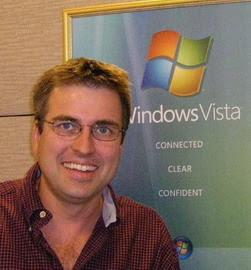In my article User Files Folders are Bilingual, I talked briefly about Vista's multilingual features. A coworker of mine took a Vista screenshot that I thought I should show you guys. It sums up Vista's support for languages other than English rather nicely:
This Vista OS was installed using the French language. If you view the full size image, you can see that it changes icon labels and things to the French language quite nicely. In fact, it is remarkable how much the root English OS can transform itself into a French looking OS. But presented here are some of the things that betray the underlying English OS.
If you look at the Windows Explorer window, you will see the folders you would expect to see on a French Vista OS - namely Programmes for the Program Files folder and Utilisateurs for the Users folder. But it turns out that these folders aren't really there. Windows Explorer knows to present those names because of the Desktop.ini file that each of those folders contains. The folders have a Friendly Name just like the User Files Folders do (see User Files Folders are Bilingual).
To see the real underlying name, one just has to go to a DOS CMD prompt. The CMD prompt does not interpret the Desktop.ini. You can see from the example provided that the Utilisateurs folder cannot be found but the Users folder can be. I don't know why Microsoft never saw fit to make the CMD prompt smart enough to interpret the Desktop.ini file. But it's probably a good thing they didn't because they also never made the Windows Explorer smart enough to suppress interpretation of the Desktop.ini so that the real file folders could be managed. (This was highlighted as a big issue in my article Folder Redirection: Not to the user's home directory.) It is a shame that the two views of the folders can't be consistent and that we users have to be smart enough to understand what is going on here.
Now the third example in the screenshot is something I really don't understand. Did you notice the Start Menu? When you type "C:\" in the Search Box, the start menu endeavors to show you the files and folders on the C: drive. But it doesn't show you them the way the Windows Explorer shows them to you - it chooses to show them to you the way the DOS CMD window shows them to you - without the Desktop.ini interpretation. I don't know why it does this since I would expect this GUI interface to be very much a user interface - whereas I can forgive the CMD oversight since it is often just used by administrators who hopefully have half a clue.
What's also puzzling about the start menu behaving this way, is the fact that the "Search Box" is supposed to be used to search for stuff on your computer - but it won't find the Utilisateurs folder because it doesn't interpret the Desktop.ini.
Now here's a question... If you are writing a guide for French users, which folder path would you tell users to follow?
- C:\Programmes\...
- C:\Program Files\...
The second choice is clearly not in the user's language and not a name they are familiar with. The user can't even browse to it since Windows Explorer doesn't display that folder name. BUT if the user types the path into a CMD window or Search Box or Windows Explorer address box, the path will be valid and succeed.
Which do you choose?

1 comment:
Well done. I didn’t even consider the effect on the documentation of a procedure…even more frustrating in that case!
Post a Comment